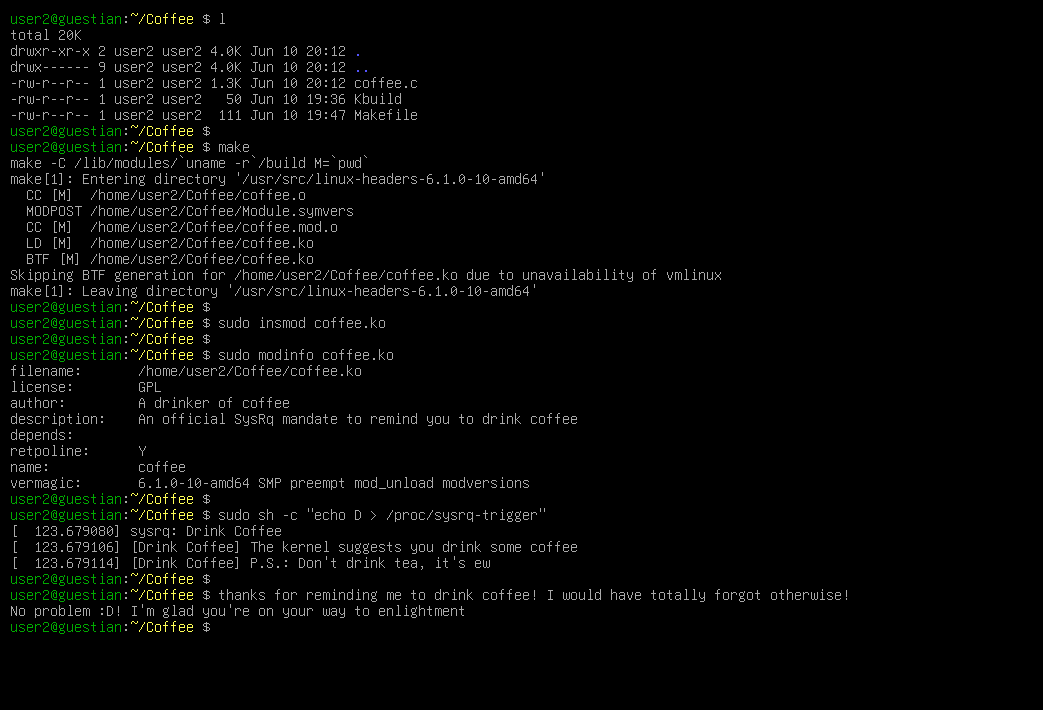Make sure to update your grub after you do. I’ve messed that one up before lol 😅
A Basil Plant
InfoSec Person | Alt-Account#2
- 8 Posts
- 58 Comments
Do you not need the
nvidia-drm.modeset=1inGRUB_CMDLINE_LINUX?https://www.if-not-true-then-false.com/2015/fedora-nvidia-guide/#262-edit-etcdefaultgrub
Could you show us the kernel command line parameters (in /etc/default/grub)? Is the modeset along with other params enabled? I’m not a fedora user, so I may not be of too much help.
https://www.linuxjournal.com/article/10754
MINIX originally was developed in 1987 by Andrew S. Tanenbaum as a teaching tool for his textbook Operating Systems Design and Implementation. Today, it is a text-oriented operating system with a kernel of less than 6,000 lines of code. MINIX’s largest claim to fame is as an example of a microkernel, in which each device driver runs as an isolated user-mode process—a structure that not only increases security but also reliability, because it means a bug in a driver cannot bring down the entire system.
In its heyday during the early 1990s, MINIX was popular among hobbyists and developers because of its inexpensive proprietary license. However, by the time it was licensed under a BSD-style license in 2000, MINIX had been overshadowed by other free-licensed operating systems.
Today, MINIX is best known as a footnote in GNU/Linux history. It inspired Linus Torvalds to develop Linux, and some of his early work was written on MINIX. Probably too, Torvalds’ early decision to support the MINIX filesystem is responsible for the Linux kernel’s support of almost every filesystem imaginable.
Later, Torvalds and Tanenbaum had a frank e-mail debate about the relative merits of macrokernels (sic) and microkernels. This early history resurfaced in 2004 when Kenneth Brown of the Alexis de Tocqueville Institution prepared a book alleging that Torvalds borrowed code from MINIX—a charge that Tanenbaum, among others, so comprehensively debunked, and the book was never actually published (see Resources).
See also: https://en.wikipedia.org/wiki/Tanenbaum–Torvalds_debate

 2·28 days ago
2·28 days agoThat’s crazy helpful - thanks!

 2·28 days ago
2·28 days agoPerfect, thanks a million! I’ll be getting on them soon!

 2·29 days ago
2·29 days agoCould you link the page which shows your exact config at that price? I can’t find anything like that. KVM, AMD, Windows VPS - I looked at all three but none suggest the price you’ve written.
That price sounds like a steal, and I’d love to get it if possible. I currently pay $6/month per VPS with Digital Ocean

 3·1 month ago
3·1 month agoFrom: https://snee.la/stash/#misc (disclaimer: this is my website)
Relevant YouTube Search: Youtube search results become super irrelevant after 6-8 results. Substitute your search query in the %s part of the url (from: /u/FrezNelson on reddit) to remove them.
https://www.youtube.com/results?search_query=%25s&sp=CAASAhAB
I’m sending this to the guy in the photo :D
(I use Debian on all my machines BTW)
I do use Signal quite a bit. Some important contacts don’t use it and hence, you see my using of WhatsApp.

 1·2 months ago
1·2 months agoThank you for your answer :D! I’ll use the equivalent of your national weather service henceforth.

 3·2 months ago
3·2 months agoJust out of curiosity, why do you dislike AccuWeather?

 3·2 months ago
3·2 months agoThis website shows the SearXNG public instances. It is updated every 24 hours, except the response times which are updated every 3 hours. It requires Javascript until the issue #9 is fixed.
I think the lack of the trailing comma is the clue here. The first three are email signatures. The last one is just saying “I’m not an ichthyologist”.

 138·2 months ago
138·2 months agoAre you talking about this: I have toyota corola?

 1·2 months ago
1·2 months agoI think the difference lies in two things:
-
You can share an article from a user of a different instance. In this case, your instance will have to look up the rel=“author” tag and check whether the URL is a fediverse instance. I’m not sure whether this is scalable as compared to a tag that directly indicates that the author is on the fediverse. Imagining a scenario where there are 100, 1000, 10,000, or 100,000 instances on different versions.
-
The tag is to promote that the author is on the fediverse. If the rel=“author” tag points to twitter for example, maybe Eugen Rochko + team didn’t want a post on the fediverse to link to twitter.
These are my thoughts and idk if they’re valid. But I think just reusing the rel=“author” isn’t the most elegant solution.
I know that mastodon already uses rel=“me” for link verification (I use it on mu website + my mastodon account), but that’s a different purpose - that’s more for verification. There’s still no way of guaranteeing that the rel=“author” tag points to a fediverse account. You’re putting the onus on the mastodon instance.
-











Ah if you messed it up, you can press “e” on the grub entry and edit the command line parameters to remove the thing that messes it up. Good luck with your fresh install [and use Debian this time… jk :)]